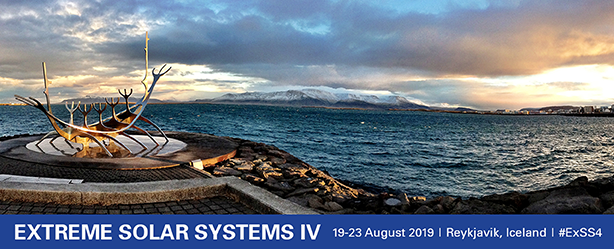Meeting on Extreme Solar Systems in a Land of Extremes

Richard Fienberg AAS Solar Eclipse Task Force

It’s been a quarter-century since the first planets were discovered orbiting other stars. In that brief time span, we’ve confirmed the existence of more than 4,000 exoplanets in about 3,000 different star systems and determined that there are probably more planets than stars in the universe. With NASA’s Transiting Exoplanet Survey Satellite (TESS) now in orbit and ESA’s CHaracterising ExOPlanet Satellite (CHEOPS) due for launch later this year, we are truly in a golden age of exoplanet science.
At this auspicious juncture, hundreds of astronomers, planetary scientists, and researchers from other relevant disciplines will gather for Extreme Solar Systems IV (ExSS IV). This conference, the fourth in a series that began in 2007, will take place at the Harpa Center in Reykjavik, Iceland, 19-23 August 2019. ExSS IV will cover all aspects of observational and theoretical studies of exoplanets, including exoplanet detection and characterization using current and planned ground- and space-based techniques; the formation of planets in extreme environments such as around binary stars and in dense star clusters; the fate of planets around evolved stars such as giants, white dwarfs, and pulsars; and the many factors affecting planetary habitability.
ExSS IV is hosted by the Center for Interdisciplinary Exploration and Research in Astrophysics (CIERA) at Northwestern University and co-sponsored by the American Astronomical Society as part of the AAS Topical Conference Series. The meeting happens to coincide approximately with the 70th birthday of Doug Lin (University of California, Santa Cruz), who co-chairs the scientific organizing committee (SOC) with Fred Rasio (CIERA/Northwestern).
The early-bird registration deadline for ExSS IV is Tuesday, 16 April. After that date, the registration fee increases by 11%, so register today!
We’ve blocked rooms in six hotels within walking distance of the Harpa Center at a range of prices. Once you register, you’ll be given the opportunity to reserve a room at the hotel of your choice — but note that one is already fully booked, so register and book your accommodation as soon as possible!
Abstract submission opens on 25 April, and the regular deadline is 30 May. We want to be sure to accommodate the latest discoveries in Reykjavik, so we will accept late abstracts through mid-July — but only for posters (with at most one or two exceptions for genuine breakthroughs). Accordingly, the scientific program for the meeting will not be finalized until late July. All presentations will be drawn from the abstracts we receive, which will be evaluated and ranked by the SOC — a virtual Who’s Who of leaders in the exoplanet community. This means that the conference program will be shaped mainly by the participants, not by the organizers.
Key Dates & Deadlines
16 April: Last day for early registration
25 April: Abstract submission opens
30 May: Regular abstract deadline
3 June: Late abstract submission opens
16 June: Accommodation reservation deadline
27 June: Last day for regular registration
11 July: Late abstract deadline
In addition to the exciting exoplanet science, of course, a major highlight of ExSS IV will be Iceland itself, a country of extreme geological contrasts. Often called “The Land of Fire and Ice,” Iceland is home to some of the world’s most active volcanoes as well as some of its largest glaciers. It is also the land of light and darkness. Long summer days with nearly 24 hours of sunshine are offset by short winter days with only a few hours of daylight. In cooperation with the AAS and the local organizing committee (LOC), chaired by Steinn Sigurdsson (Penn State University), Iceland Travel has prepared special tours for ExSS IV attendees to showcase the country’s natural phenomena and the life of its people, past and present.
Tours will be held at the midpoint of the conference, on the afternoon of 21 August, and you’ll have your choice of three different itineraries, each including afternoon snacks and dinner. Sights included on the various tours include the parliament plains at Thingvellir, a UNESCO World Heritage site where Vikings convened as far back as 930 AD; Iceland's best-known waterfall, Gullfoss, where glacial meltwater plunges 32 meters; and Geysir, where you can see the hot spring that gives name to the world´s geysers.
Other possible tour stops include Kaldidalur (Cold Valley), where numerous Mars-analog features can be observed in the landscape; the geothermal power plant at Hellisheiði; several volcanoes that have either recently erupted or show definite signs of upcoming activity; the valley glacier Sólheimajökull, where you can learn about the rapid retreat of glaciers due to climate change; or the historical site Reykholt, where the chieftain Snorri Sturluson lived in the early 13th century and wrote several of the most important works of the Icelandic Saga literature.
We hope to see you in Iceland!

